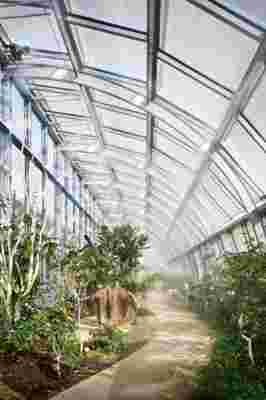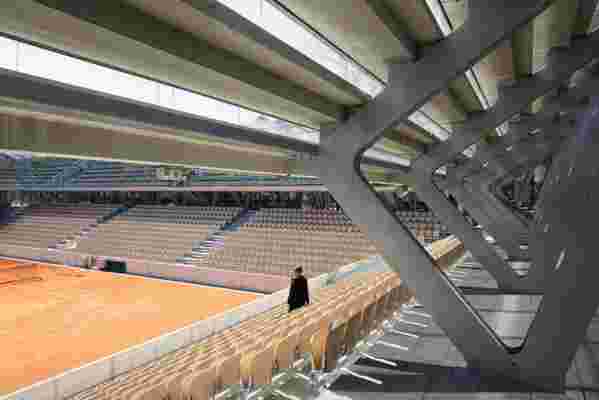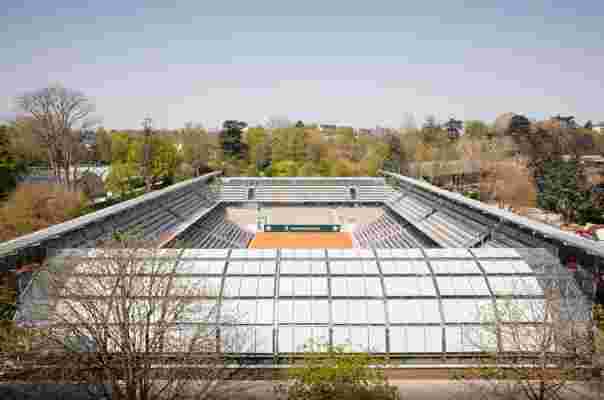The newest and most incroyable court in professional tennis—part of a multiyear, €380 million renovation of Roland Garros Stadium in Paris—had a long journey to completion. Not to mention a groundbreaking one. Court Simonne-Mathieu was built under duress. It’s situated in the Jardin des Serres d'Auteuil, a botanical garden in the Bois de Boulogne, a 2,100-acre park adjacent to Roland Garros. And over the years there were enforced delays, 20 public meetings, and eight court hearings with city officials, environmental groups, residents, and other interested parties.

Inside one of the four greenhouses that frame the court.
That’s largely because the garden has thousands of rare flowers and plants from five continents, and 65,000 square feet of greenhouses built in 1898, protected by a city landmarks office—and public sentiment. "It was the first fake news in France,” says project architect-engineer Marc Mimram , describing published stories and claims that the greenhouses would be destroyed. But that was never in the master plan, which was developed in 2011 with landscape architect Michel Corajoud, whose specialty is environmentally minded urban planning. Mimram works similarly. “It’s important to have a relationship with the landscape,” he says. Respectfully integrating a contemporary building within the historic garden was always the goal.
Construction was authorized in 2015 and completed last September, followed by landscaping led by Atelier KABA and the Gardens of Paris group. The entire project wrapped up in January. The new greenhouses were designed to complement the existing ones, and to protect some 1,000 plants with efficient glass and a canopy of 900 tiles created by shifted-edge-double glazing, a method that eliminates traditional joints and produces a scale-like effect, with clean architectural lines.

Three fifths of the court’s 5,000 seats are concrete benches; the others are made with wood from the Vosges mountains, by French furnituremaker Delagrave.
Each of the four new greenhouses has a climate suited to its particular plants (e.g., arid and hot for Australian desert species). They frame the court, built 15 feet below ground in deference to the old greenhouses. Nothing exceeds the original 26-foot height. Three fifths of the court’s 5,000 seats are on the second level, on concrete benches.
“At Roland Garros we united nature and landscape and garden with sport,” says Mimram. He believes sports arenas should share and enhance public space. The French Tennis Federation apparently agrees: Going green is the theme of this year’s tournament. Accordingly, there’s also a new lawn for spectators. The creation of Court Simonne-Mathieu foreshadows the demolition of the 3,800-seat Court 1, which will be replaced by a 2.5-acre green space.

The new court was built inside the Jardin des Serres.
Simonne Mathieu, who died in 1980, was France’s second most successful women's tennis player, a Hall of Famer with 13 Grand Slam wins (mostly in doubles). Her court ranks third in importance, after Court Suzanne Lenglen (the number-one French female player) and Court Philippe Chatrier (a player whose greatest tennis accomplishments were off the court).
The 2019 French Open runs through June 9. The first players to compete on the new court have not yet been announced. The greenhouses will open to the public on June 21.
